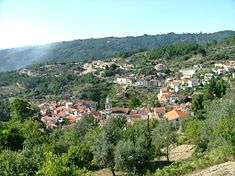Church of São Gião
| Church of São Gião (Igreja de São Gião) | |
| Parochial Church of St. Julian | |
| Church (Igreja) | |
 A view of the town of São Gião, with the church peaking in the middle | |
| Official name: Igreja Paroquial de São Gião/Igreja de São Gião | |
| Named for: Julian of Antioch | |
| Country | |
|---|---|
| Region | Centro |
| Subregion | Pinhal Interior Norte |
| District | Coimbra |
| Municipality | Oliveira do Hospital |
| Location | São Gião |
| - coordinates | PT 40°20′12.9″N 7°47′57.3″W / 40.336917°N 7.799250°WCoordinates: PT 40°20′12.9″N 7°47′57.3″W / 40.336917°N 7.799250°W |
| Styles | Baroque, Roccoco |
| Materials | Masonry, Limestone, Azulejo, Wood, Tile |
| Owner | Portuguese Republic |
| For public | Public |
| Easiest access | São Gião |
| Management | Instituto Gestão do Patrimonio Arquitectónico e Arqueológico |
| Operator | Roman Catholic Diocese of Guarda |
| Status | Monument of Public Interest Monumento de Interesse Público |
| Listing | Special Protection Zone (ZEP), Ordinance 740-BN/2012, Diário da República, Série 2, 248 (24 December 2012) |
| Wikimedia Commons: Church of São Gião (Oliveira do Hospital) | |
A Church of São Gião (Portuguese: Igreja Paroquial de São Gião/Igreja de São Gião) is an 18th century church in the civil parish of São Gião, in the municipality of Oliveira do Hospital, in the Portuguese district of Coimbra. Classified as a national monument since 1910, it is locally known as the Cathedral das Beiras (Cathedral of Beiras), although unrecognized by IGESPAR or the Diocese of Guarda.[1]
History
The parish was founded in 1756.[1] By the middle of the 18th century, the parochial church was re-constructed; by 1795, during the reign of King D. Maria, worked had continued on the presbytery and lateral altars, that also included paintings and main chapel.[1]
The high choir was constructed in the 19th century.[1]
On 20 July 1991, there was a proposal to classify the Fábrica da Igreja (the old church factory) as a heritage site.[1] By 7 February 2003, a dispatch from the vice-president of the IPPAR (forerunner of the IGESPAR) showed the intention of the national body to advance with a process of classification.[1] It was supported on 10 December 2007, by the DRCoimbra, that suggested classifying the area around it as a special protection zone, and as an IIP Imóvel de Interesse Público (Property of Public Interest).[1] The Conselho Consultivo (Consultative Council) of IGESPAR, supported the new designation on 3 March 2009 (re-reiterated on 15 July 2009).[1]
Architecture
The church is situated in the centre of the small town of São Gião, in a central square, surrounded by historic buildings.
Constructed during the Baroque period, it included two panels attributed to the Italian, Pascal Parente, then living in Coimbra. The main retable is attributed to sculptor António Neves and carver Jose Ribeiro da Fonseca from Beiras, in the last part of the 18th century.
See also
References
Notes
Sources
- Gonçalves, Nogueira, A.; Correia, Vergílio (1953), Inventário Artístico de Portugal (in Portuguese), Lisbon, Portugal